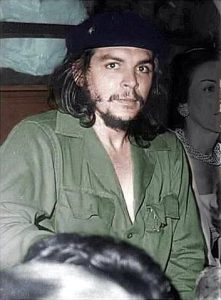Chapter Seven – Love and Executions
Notes on Che Guevara
Ernesto “Che” Guevara 1928-1967

Early Life
- Born to an upper-middle class family of leftist leanings
- Had Asthma, but played rugby still. Attended medical school
- “‘Che’ is fairly intellectual for a Latino” (CIA report)
- In 1948, traveled through Latin America in a motorcycle. He is further radicalized by what he saw
- Returns home and gets his Medical Doctor degree
- Arrives in Mexico in 1954, after resisting CIA-organized bloody coup against democratically elected Guatemalan President Arbenz
The Cuban Period
- Meets Raúl and Fidel Castro in 1955 in Mexico
- Joins the Granma expedition in 1956
Sierra Maestra
- Guevara, initially admitted because of his medical skills, soon becomes Commander of an insurgent column
- Beloved commander, he was also a ruthless executioner of informants, rapists, deserters and others who put the insurgency at risk
- Took the town of Santa Clara with numbers against him 10 to 1
- First Commander to enter Havana January 1959
Cuba and Beyond
- Serves under different capacities in the revolutionary government, including Minister of Finances
- Increasingly disillusioned with USSR, leaves Cuba in 1965 to help with Congo’s insurrection. Inspired his writing, Create Two, Three, Many Vietnams (link in “Additional Reading and Writing section at end of Chapter)
- Arrives in La Paz, Bolivia in 1966
- Sets up a guerrilla in a bad location, following disagreements with Bolivian CP
- In 1967, Bolivian army execute Guevara at La Higuera (CIA and CP involvement)
Legacy
- “New Man”
- Guerrilla tactics
- Critique of Soviet Union
- Proletarian Internationalism
- World Revolution (Create Two, Three, Many Vietnams)
Main Concepts
- Alienation
- Surplus value
- Bourgeois Art as escape
- Vanguardism and Masses
- Egalitarianism
- Self-sacrifice
Media Attributions
- Che Guevara in his trademark olive-green military fatigues, June 2, 1959 Cuba. © Unknown is licensed under a Public Domain license

